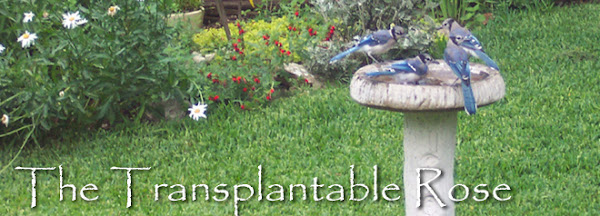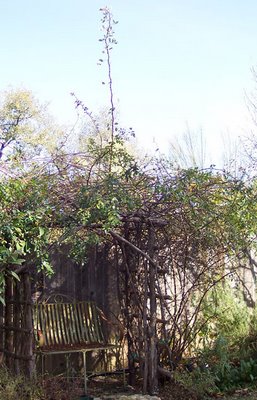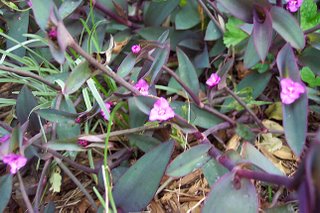
Many things have been started – few things have been finished – most things are stuck somewhere in the middle. At the beginning of this year the word I chose as my theme for 2006 was, “Decide” – and now in November it’s time to drag this word out again and repeat it over and over, hoping it can jolt me out of my mental inertia.
It’s been so warm that I didn’t bring the two Plumeria trees inside yet, and still haven’t figured out where I can fit them. After 7 months in the garden, both are in larger pots with much longer branches, so the corner of the garage is going to be really tight. The Hawaiian White Ginger needs to go in the ground, but where? The evergreen Hibiscus used to fit in the kitchen near the window, but it’s doubled in size. Should I prune it severely? Will that kill it? Can the Aloe vera stay out or is it tender? The Meyer’s Lemon is still in the pot by the door, and will probably come in and out for this winter. I’m still not sure where I want to put the daylily from Pam. There are a few peppers left hanging in the vegetable garden, in hopes they’ll be a little bigger by the time the cold cuts them down.
The weather has been pleasant and dry and the leaves are falling – so I'd better water all the containers and whatever’s been recently planted & transplanted. We want to put the Christmas tree up this week, so I'll start to move the furniture from that corner. I need to do some Christmas shopping, but I don't have a car today. Maybe I should write a few cards… but first I’ll answer email. I haven't posted in a week, but first I'll read a few garden blogs. I'll make up my mind after I eat the last bowl of turkey soup.
Then at 3 AM Monday I woke up to the sound of rain hitting the roof, maybe a third of an inch, bringing down another batch of leaves. The prediction now is for possible drizzle, with a few more warm days – then a freeze on Thursday and Friday. So my dithering must end and it’s time to Decide.
 For decades of Thanksgiving feasts and Christmas dinners in Illinois, my mom has made a raw cranberry relish, and we use her recipe here in Texas. You’ve probably tasted it or maybe you make it yourself, with a bag of raw cranberries, a whole orange and a little sugar, chopped fine in a food processor or in batches in a blender. The Meyer's Lemon tree has produced some ripe fruit, with half-a-dozen lemons still to come. This year we made our relish with 2 bags of raw cranberries, 2 Meyer's lemons and one whole Satsuma orange, adding just barely enough raw sugar.
For decades of Thanksgiving feasts and Christmas dinners in Illinois, my mom has made a raw cranberry relish, and we use her recipe here in Texas. You’ve probably tasted it or maybe you make it yourself, with a bag of raw cranberries, a whole orange and a little sugar, chopped fine in a food processor or in batches in a blender. The Meyer's Lemon tree has produced some ripe fruit, with half-a-dozen lemons still to come. This year we made our relish with 2 bags of raw cranberries, 2 Meyer's lemons and one whole Satsuma orange, adding just barely enough raw sugar.  We were amazed at the sparkle and flavor the lemons added to this old favorite.
We were amazed at the sparkle and flavor the lemons added to this old favorite. You see? I couldn’t even decide how to write this post! Should I talk about the relish recipe or whine and ramble about indecision at the end of November?
Both.





















 I rooted some several years ago, and they grew in a hanging basket on the covered porch. The coco liner was disintegrating when we moved here, so I sort of flipped the whole thing out into my new woodland area, the Divas of the Dirt project for October 2004, just leaving it on top of the soil. The little colony quickly rooted and has been very happy in this shady area - seeing them at this time of year makes me happy, too.
I rooted some several years ago, and they grew in a hanging basket on the covered porch. The coco liner was disintegrating when we moved here, so I sort of flipped the whole thing out into my new woodland area, the Divas of the Dirt project for October 2004, just leaving it on top of the soil. The little colony quickly rooted and has been very happy in this shady area - seeing them at this time of year makes me happy, too.